Asymmetric Organocatalysis—A Powerful Technology Platform for Academia and Industry: Pregabalin as a Case Study
Abstract
:1. Introduction
2. Pregabalin
3. Conclusions
Author Contributions
Funding
Data Availability Statement
Conflicts of Interest
References
- The Nobel Prize in Chemistry 2021—NobelPrize.Org. Available online: https://www.nobelprize.org/prizes/chemistry/2021/summary/ (accessed on 20 July 2022).
- List, B.; Lerner, R.A.; Barbas, C.F. Proline-Catalyzed Direct Asymmetric Aldol Reactions. J. Am. Chem. Soc. 2000, 122, 2395–2396. [Google Scholar] [CrossRef]
- Ahrendt, K.A.; Borths, C.J.; MacMillan, D.W.C. New Strategies for Organic Catalysis: The First Highly Enantioselective Organocatalytic Diels—Alder Reaction. J. Am. Chem. Soc. 2000, 122, 4243–4244. [Google Scholar] [CrossRef]
- Melchiorre, P.; Marigo, M.; Carlone, A.; Bartoli, G. Asymmetric Aminocatalysis—Gold Rush in Organic Chemistry. Angew. Chem. Int. Ed. 2008, 47, 6138–6171. [Google Scholar] [CrossRef] [PubMed]
- Aukland, M.H.; List, B. Organocatalysis Emerging as a Technology. Pure Appl. Chem. 2021, 93, 1371–1381. [Google Scholar] [CrossRef]
- Carlone, A.; Bernardi, L. Enantioselective Organocatalytic Approaches to Active Pharmaceutical Ingredients—Selected Industrial Examples. Phys. Sci. Rev. 2019, 4, 20180097. [Google Scholar] [CrossRef]
- Bernardi, L.; Carlone, A.; Fini, F. Industrial Relevance of Asymmetric Organocatalysis in the Preparation of Chiral Amine Derivatives. In Methodologies in Amine Synthesis: Challenges and Applications; Ricci, A., Bernardi, L., Eds.; WILEY-VCH GmbH: Boschstr, Germany, 2020; pp. 187–241. [Google Scholar]
- Hughes, D.L. Highlights of the Recent Patent Literature: Focus on Asymmetric Organocatalysis. Org. Process Res. Dev. 2022, in press. [Google Scholar] [CrossRef]
- Eder, U.; Sauer, G.; Wiechert, R. New Type of Asymmetric Cyclization to Optically Active Steroid CD Partial Structures. Angew. Chem. Int. Ed. 1971, 10, 496–497. [Google Scholar] [CrossRef]
- Hajos, Z.G.; Parrish, D.R. Synthesis and Conversion of 2-Methyl-2-(3-Oxobutyl)-1,3-Cyclopentanedione to the Isomeric Racemic Ketols of the [3.2.1] Bicyclooctane and of the Perhydroindane Series. J. Org. Chem. 1974, 39, 1612–1615. [Google Scholar] [CrossRef]
- Dolling, U.H.; Davis, P.; Grabowski, E.J.J. Efficient Catalytic Asymmetric Alkylations. 1. Enantioselective Synthesis of (+)-Indacrinone via Chiral Phase-Transfer Catalysis. J. Am. Chem. Soc. 1984, 106, 446–447. [Google Scholar] [CrossRef]
- Fulgheri, T.; Della Penna, F.; Baschieri, A.; Carlone, A. Advancements in the Recycling of Organocatalysts: From Classical to Alternative Approaches. Curr. Opin. Green Sustain. Chem. 2020, 25, 100387–100396. [Google Scholar] [CrossRef]
- Gruttadauria, M.; Giacalone, F.; Noto, R. Supported Proline and Proline-Derivatives as Recyclable Organocatalysts. Chem. Soc. Rev. 2008, 37, 1666–1688. [Google Scholar] [CrossRef] [PubMed]
- Giacalone, F.; Gruttadauria, M.; Agrigento, P.; Noto, R. Low-Loading Asymmetric Organocatalysis. Chem. Soc. Rev. 2012, 41, 2406–2447. [Google Scholar] [CrossRef] [PubMed]
- Kaib, P.S.J.; Schreyer, L.; Lee, S.; Properzi, R.; List, B. Extremely Active Organocatalysts Enable a Highly Enantioselective Addition of Allyltrimethylsilane to Aldehydes. Angew. Chem. Int. Ed. 2016, 55, 13200–13203. [Google Scholar] [CrossRef] [PubMed]
- Martín-Rapún, R.; Fan, X.; Sayalero, S.; Bahramnejad, M.; Cuevas, F.; Pericàs, M.A. Highly Active Organocatalysts for Asymmetric Anti-Mannich Reactions. Chem. Eur. J. 2011, 17, 8780–8783. [Google Scholar] [CrossRef]
- Bae, H.Y.; Höfler, D.; Kaib, P.S.J.; Kasaplar, P.; De, C.K.; Döhring, A.; Lee, S.; Kaupmees, K.; Leito, I.; List, B. Approaching Sub-Ppm-Level Asymmetric Organocatalysis of a Highly Challenging and Scalable Carbon–Carbon Bond Forming Reaction. Nat. Chem. 2018, 10, 888–894. [Google Scholar] [CrossRef]
- Benaglia, M.; Alessandra, M. Catalyst Immobilization: Methods and Applications; WILEY-VCH Verlag GmbH & Co. KGaA: Weinheim, Germany, 2019; pp. 1–477. [Google Scholar]
- Benaglia, M.; Puglisi, A.; Cozzi, F. Polymer-Supported Organic Catalysts. Chem. Rev. 2003, 103, 3401–3429. [Google Scholar] [CrossRef]
- Zhang, L.; Luo, S.; Cheng, J.P. Non-Covalent Immobilization of Asymmetric Organocatalysts. Catal. Sci. Tech. 2011, 1, 507–516. [Google Scholar] [CrossRef]
- Lai, J.; Fianchini, M.; Pericas, M.A. Development of Immobilized Spinol-Derived Chiral Phosphoric Acids for Catalytic Continuous Flow Processes. Use in the Catalytic Desymmetrization of 3,3-Disubstituted Oxetanes. Acs Catal. 2020, 10, 14971–14983. [Google Scholar] [CrossRef]
- Ragno, D.; Di Carmine, G.; Brandolese, A.; Bortolini, O.; Giovannini, P.P.; Massi, A. Immobilization of Privileged Triazolium Carbene Catalyst for Batch and Flow Stereoselective Umpolung Processes. ACS Catal. 2017, 7, 6365–6375. [Google Scholar] [CrossRef]
- Corma, A.; Garcia, H. Silica-Bound Homogenous Catalysts as Recoverable and Reusable Catalysts in Organic Synthesis. Adv. Synth. Cat. 2006, 348, 1391–1412. [Google Scholar] [CrossRef]
- Di Carmine, G.; Forster, L.; Wang, S.; Parlett, C.; Carlone, A.; D’Agostino, C. NMR Relaxation Time Measurements of Solvent Effects in an Organocatalysed Asymmetric Aldol Reaction over Silica SBA-15 Supported Proline. React. Chem. Eng. 2022, 7, 269–274. [Google Scholar] [CrossRef]
- Di Carmine, G.; Pesciaioli, F.; Wang, S.; Sinibaldi, A.; Giorgianni, G.; Parlett, C.M.A.; Carlone, A.; D’Agostino, C. Insights into Substituent Effects of Benzaldehyde Derivatives in a Heterogenous Organocatalyzed Aldol Reaction. ChemCatChem 2022, 14, e202200405. [Google Scholar] [CrossRef]
- Sinibaldi, A.; Nori, V.; Baschieri, A.; Fini, F.; Arcadi, A.; Carlone, A. Organocatalysis and beyond: Activating Reactions with Two Catalytic Species. Catalysts 2019, 9, 928. [Google Scholar] [CrossRef]
- Allen, A.E.; MacMillan, D.W.C. Synergistic Catalysis: A Powerful Synthetic Strategy for New Reaction Development. Chem. Sci. 2012, 3, 633–658. [Google Scholar] [CrossRef]
- Del Vecchio, A.; Sinibaldi, A.; Nori, V.; Giorgianni, G.; di Carmine, G.; Pesciaioli, F. Synergistic Strategies in Aminocatalysis. Chem. Eur. J. 2022, e202200818. [Google Scholar] [CrossRef]
- Inamdar, S.M.; Shinde, V.S.; Patil, N.T. Enantioselective Cooperative Catalysis. Organ. Biomol. Chem. 2015, 13, 8116–8162. [Google Scholar] [CrossRef]
- Afewerki, S.; Córdova, A. Combinations of Aminocatalysts and Metal Catalysts: A Powerful Cooperative Approach in Selective Organic Synthesis. Chem. Rev. 2016, 116, 13512–13570. [Google Scholar] [CrossRef]
- Wende, R.C.; Schreiner, P.R. Evolution of Asymmetric Organocatalysis: Multi- and Retrocatalysis. Green Chem. 2012, 14, 1821–1849. [Google Scholar] [CrossRef]
- Chen, Z.; Yang, Q.-Q.; Du, W.; Chen, Y.-C. Asymmetric Organocatalysis Involving Double Activation. Tetrahedron Chem. 2022, 2, 100017. [Google Scholar] [CrossRef]
- Nori, V.; Sinibaldi, A.; Giorgianni, G.; Pesciaioli, F.; Di Donato, F.; Cocco, E.; Biancolillo, A.; Landa, A.; Carlone, A. DoE-Driven Development of an Organocatalytic Enantioselective Addition of Acetaldehyde to Nitrostyrenes in Water. Chem. Eur. J. 2022, 28, e202104524. [Google Scholar] [CrossRef]
- Nori, V.; Sinibaldi, A.; Pesciaioli, F.; Carlone, A. Impact of Design of Experiments in the Optimisation of Catalytic Reactions in Academia. Synthesis 2022, 54. [Google Scholar] [CrossRef]
- Renzi, P.; Kronig, C.; Carlone, A.; Eröksüz, S.; Berkessel, A.; Bella, M. Kinetic Resolution of Oxazinones: Rational Exploration of Chemical Space through the Design of Experiments. Chem. Eur. J. 2014, 20, 11768–11775. [Google Scholar] [CrossRef] [PubMed]
- Renzi, P.; Bella, M. Design of Experiments: A Rational Approach toward Non-Covalent Asymmetric Organocatalysis. Synlett 2017, 28, 306–315. [Google Scholar] [CrossRef]
- Adamo, M.F.A.; Kelly, B.G.; Moccia, M. Recent Advances in the Preparation of Active Pharmaceutical Ingredient (S)-Pregabalin. Chim. Oggi Chem. Today 2016, 34, 54–57. [Google Scholar]
- McGrath, N.A.; Brichacek, M.; Njardarson, J.T. A Graphical Journey of Innovative Organic Architectures That Have Improved Our Lives. J. Chem. Edu. 2010, 87, 1348–1349. [Google Scholar] [CrossRef]
- Silverman, R.B. From Basic Science to Blockbuster Drug: The Discovery of Lyrica. Angew. Chem. Int. Ed. 2008, 47, 3500–3504. [Google Scholar] [CrossRef]
- Burk, M.J.; de Koning, P.D.; Grote, T.M.; Hoekstra, M.S.; Hoge, G.; Jennings, R.A.; Kissel, W.S.; Le, T.v.; Lennon, I.C.; Mulhern, T.A.; et al. An Enantioselective Synthesis of (S)-(+)-3-Aminomethyl-5-Methylhexanoic Acid via Asymmetric Hydrogenation. J. Org. Chem. 2003, 68, 5731–5734. [Google Scholar] [CrossRef]
- Hoge, G.; Wu, H.P.; Kissel, W.S.; Pflum, D.A.; Greene, D.J.; Bao, J. Highly Selective Asymmetric Hydrogenation Using a Three Hindered Quadrant Bisphosphine Rhodium Catalyst. J. Am. Chem. Soc. 2004, 126, 5966–5967. [Google Scholar] [CrossRef]
- Debarge, S.; McDaid, P.; O’Neill, P.; Frahill, J.; Wong, J.W.; Carr, D.; Burrell, A.; Davies, S.; Karmilowicz, M.; Steflik, J. Evaluation of Several Routes to Advanced Pregabalin Intermediates: Synthesis and Enantioselective Enzymatic Reduction Using Ene-Reductases. Org. Process Res. Dev. 2014, 18, 109–121. [Google Scholar] [CrossRef]
- Process for the Preparation of (S)—3—CYANO—5—METHYLHEXANOIC Acid Derivatives and of Pregabalin, WO2012025861. Available online: https://patentscope.wipo.int/search/en/detail.jsf?docId=WO2012025861 (accessed on 6 July 2022).
- Winkler, C.K.; Clay, D.; Davies, S.; O’Neill, P.; McDaid, P.; Debarge, S.; Steflik, J.; Karmilowicz, M.; Wong, J.W.; Faber, K. Chemoenzymatic Asymmetric Synthesis of Pregabalin Precursors via Asymmetric Bioreduction of β-Cyanoacrylate Esters Using Ene-Reductases. J. Org. Chem. 2013, 78, 1525–1533. [Google Scholar] [CrossRef]
- Martinez, C.A.; Hu, S.; Dumond, Y.; Tao, J.; Kelleher, P.; Tully, L. Development of a Chemoenzymatic Manufacturing Process for Pregabalin. Org. Process Res. Dev. 2008, 12, 392–398. [Google Scholar] [CrossRef]
- Ordóñez, M.; Cativiela, C. Stereoselective Synthesis of γ-Amino Acids. Tetrahedron: Asymm. 2007, 18, 3–99. [Google Scholar] [CrossRef]
- Ordóñez, M.; Cativiela, C.; Romero-Estudillo, I. An Update on the Stereoselective Synthesis of γ-Amino Acids. Tetrahedron: Asymm. 2016, 27, 999–1055. [Google Scholar] [CrossRef]
- Han, J.; Escorihuela, J.; Fustero, S.; Landa, A.; Soloshonok, V.A.; Sorochinsky, A. Asymmetric Michael Addition in Synthesis of β-Substituted GABA Derivatives. Molecules 2022, 27, 3797. [Google Scholar] [CrossRef] [PubMed]
- Liu, Y.; Shirakawa, S.; Maruoka, K. Phase-Transfer-Catalyzed Asymmetric Conjugate Cyanation of Alkylidenemalonates with KCN in the Presence of a Brønsted Acid Additive. Org. Lett. 2013, 15, 1230–1233. [Google Scholar] [CrossRef] [PubMed]
- Hameršak, Z.; Stipetić, I.; Avdagić, A. An Efficient Synthesis of (S)-3-Aminomethyl-5-Methylhexanoic Acid (Pregabalin) via Quinine-Mediated Desymmetrization of Cyclic Anhydride. Tetrahedron Asymm. 2007, 18, 1481–1485. [Google Scholar] [CrossRef]
- Bolm, C.; Schiffers, I.; Dinter, C.L.; Gerlach, A. Practical and Highly Enantioselective Ring Opening of Cyclic Meso-Anhydrides Mediated by Cinchona Alkaloids. J. Org. Chem. 2000, 65, 6984–6991. [Google Scholar] [CrossRef]
- Moccia, M.; Cortigiani, M.; Monasterolo, C.; Torri, F.; del Fiandra, C.; Fuller, G.; Kelly, B.; Adamo, M.F.A. Development and Scale-up of an Organocatalytic Enantioselective Process to Manufacture (S)-Pregabalin. Org. Process Res. Dev. 2015, 19, 1274–1281. [Google Scholar] [CrossRef]
- WO2013076225 Process for the Preparation of Gamma Amino Acids and Intermediates Used in Said Process. Available online: https://patentscope.wipo.int/search/en/detail.jsf?docId=WO2013076225 (accessed on 23 July 2022).
- Nagaraju, S.; Sathish, K.; Kashinath, D. Applications of 3,5-Dialkyl-4-Nitroisoxazoles and Their Derivatives in Organic Synthesis. ChemistrySelect 2021, 6, 7736–7793. [Google Scholar] [CrossRef]
- Gotoh, H.; Ishikawa, H.; Hayashi, Y. Diphenylprolinol Silyl Ether as Catalyst of an Asymmetric, Catalytic, and Direct Michael Reaction of Nitroalkanes with α,β-Unsaturated Aldehydes. Org. Lett. 2007, 9, 5307–5309. [Google Scholar] [CrossRef]
- Xu, F.; Zacuto, M.; Yoshikawa, N.; Desmond, R.; Hoerrner, S.; Itoh, T.; Journet, M.; Humphrey, G.R.; Cowden, C.; Strotman, N.; et al. Asymmetric Synthesis of Telcagepant, a CGRP Receptor Antagonist for the Treatment of Migraine. J. Org. Chem. 2010, 75, 7829–7841. [Google Scholar] [CrossRef] [PubMed]
- Bassas, O.; Huuskonen, J.; Rissanen, K.; Koskinen, A.M.P. A Simple Organocatalytic Enantioselective Synthesis of Pregabalin. Eur. J. Org. Chem. 2009, 2009, 1340–1351. [Google Scholar] [CrossRef]
- Okino, T.; Hoashi, Y.; Takemoto, Y. Enantioselective Michael Reaction of Malonates to Nitroolefins Catalyzed by Bifunctional Organocatalysts. J. Am. Chem. Soc. 2003, 125, 12672–12673. [Google Scholar] [CrossRef] [PubMed]
- Li, H.; Wang, Y.; Tang, L.; Deng, L. Highly Enantioselective Conjugate Addition of Malonate and β-Ketoester to Nitroalkenes: Asymmetric C-C Bond Formation with New Bifunctional Organic Catalysts Based on Cinchona Alkaloids. J. Am. Chem. Soc. 2004, 126, 9906–9907. [Google Scholar] [CrossRef]
- Ye, J.; Dixon, D.J.; Hynes, P.S. Enantioselective Organocatalytic Michael Addition of Malonate Esters to Nitro Olefins Using Bifunctional Cinchonine Derivatives. Chem. Comm. 2005, 35, 4481–4483. [Google Scholar] [CrossRef]
- McCooey, S.H.; Connon, S.J. Urea- and Thiourea-Substituted Cinchona Alkaloid Derivatives as Highly Efficient Bifunctional Organocatalysts for the Asymmetric Addition of Malonate to Nitroalkenes: Inversion of Configuration at C9 Dramatically Improves Catalyst Performance. Angew. Chem. Int. Ed. 2005, 44, 6367–6370. [Google Scholar] [CrossRef]
- Malerich, J.P.; Hagihara, K.; Rawal, V.H. Chiral Squaramide Derivatives Are Excellent Hydrogen Bond Donor Catalysts. J. Am. Chem. Soc. 2008, 130, 14416–14417. [Google Scholar] [CrossRef]
- Liu, J.M.; Wang, X.; Ge, Z.M.; Sun, Q.; Cheng, T.M.; Li, R.T. Solvent-Free Organocatalytic Michael Addition of Diethyl Malonate to Nitroalkenes: The Practical Synthesis of Pregabalin and γ-Nitrobutyric Acid Derivatives. Tetrahedron 2011, 67, 636–640. [Google Scholar] [CrossRef]
- WO2015189068 Method for the Preparation of Beta-Substituted Gamma-Amino Carboxylic Acids. Available online: https://patentscope.wipo.int/search/en/detail.jsf?docId=WO2015189068 (accessed on 31 July 2022).
- Baran, R.; Veverková, E.; Škvorcová, A.; Šebesta, R. Enantioselective Michael Addition of 1,3-Dicarbonyl Compounds to a Nitroalkene Catalyzed by Chiral Squaramides—A Key Step in the Synthesis of Pregabalin. Org. Biomol. Chem. 2013, 11, 7705–7711. [Google Scholar] [CrossRef]
- Bae, H.Y.; Song, C.E. Unprecedented Hydrophobic Amplification in Noncovalent Organocatalysis “on Water”: Hydrophobic Chiral Squaramide Catalyzed Michael Addition of Malonates to Nitroalkenes. ACS Catal. 2015, 5, 3613–3619. [Google Scholar] [CrossRef]
- Carlone, A.; Bernardi, L.; McCormack, P.; Warr, T.; Oruganti, S.; Cobley, C.J. Asymmetric Organocatalysis and Continuous Chemistry for an Efficient and Cost-Competitive Process to Pregabalin. Org. Process Res. Dev. 2021, 25, 2795–2805. [Google Scholar] [CrossRef]
- Yang, J.W.; Chandler, C.; Stadler, M.; Kampen, D.; List, B. Proline-Catalysed Mannich Reactions of Acetaldehyde. Nature 2008, 452, 453–455. [Google Scholar] [CrossRef] [PubMed]
- Hayashi, Y.; Itoh, T.; Aratake, S.; Ishikawa, H. A Diarylprolinol in an Asymmetric, Catalytic, and Direct Crossed-Aldol Reaction of Acetaldehyde. Angew. Chem. Int. Ed. 2008, 47, 2082–2084. [Google Scholar] [CrossRef] [PubMed]
- Hayashi, Y.; Itoh, T.; Ohkubo, M.; Ishikawa, H. Asymmetric Michael Reaction of Acetaldehyde Catalyzed by Diphenylprolinol Silyl Ether. Angew. Chem. Int. Ed. 2008, 47, 4722–4724. [Google Scholar] [CrossRef]
- García-García, P.; Ladépêche, A.; Halder, R.; List, B. Catalytic Asymmetric Michael Reactions of Acetaldehyde. Angew. Chem. Int. Ed. 2008, 47, 4719–4721. [Google Scholar] [CrossRef]
- Fan, X.; Rodríguez-Escrich, C.; Sayalero, S.; Pericàs, M.A. Paraldehyde as an Acetaldehyde Precursor in Asymmetric Michael Reactions Promoted by Site-Isolated Incompatible Catalysts. Chem. Eur. J. 2013, 19, 10814–10817. [Google Scholar] [CrossRef]
- Giorgianni, G.; Nori, V.; Baschieri, A.; Palombi, L.; Carlone, A. Organocatalyzed Michael Addition to Nitroalkenes via Masked Acetaldehyde. Catalysts 2020, 10, 1296. [Google Scholar] [CrossRef]
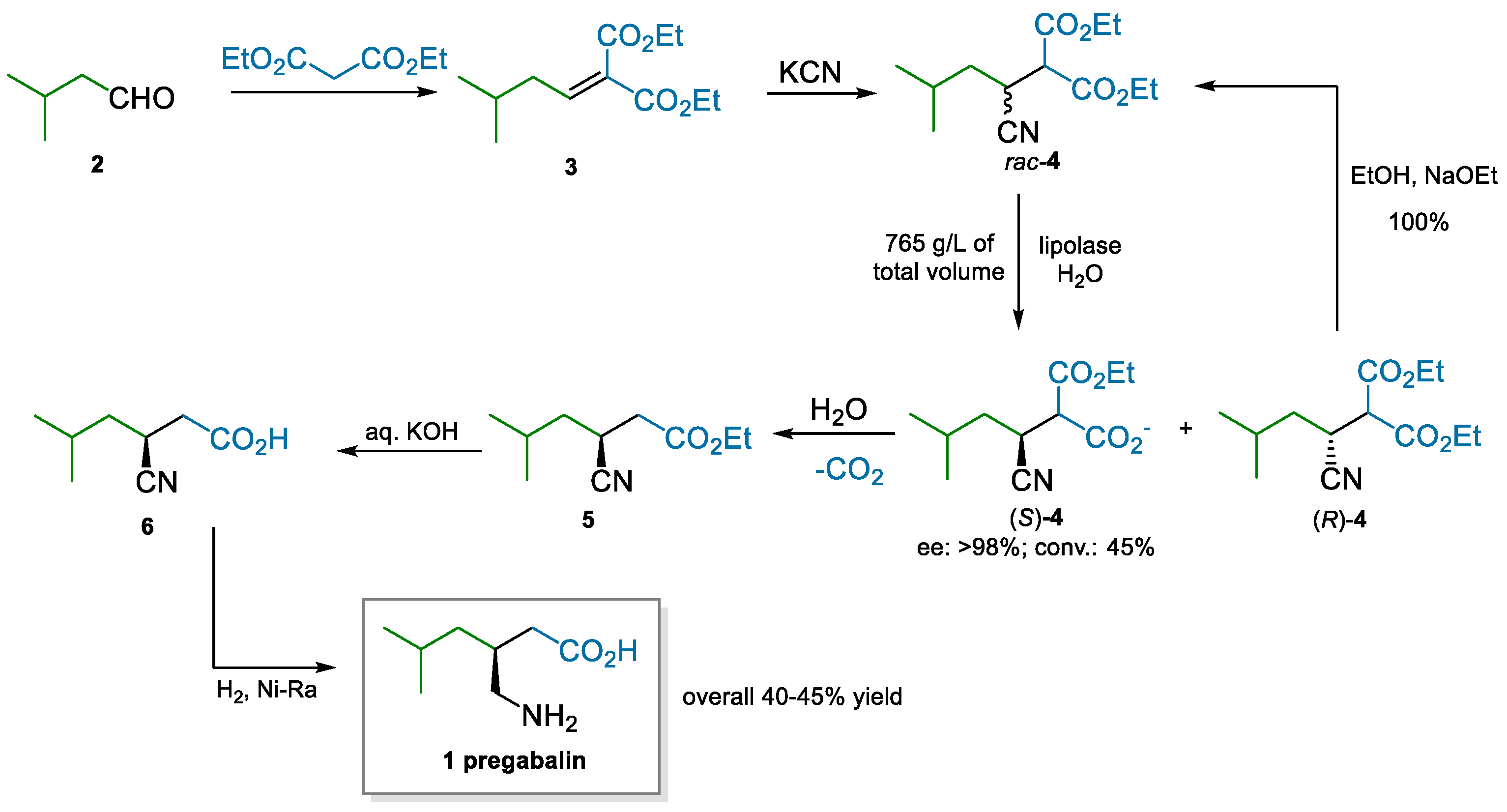

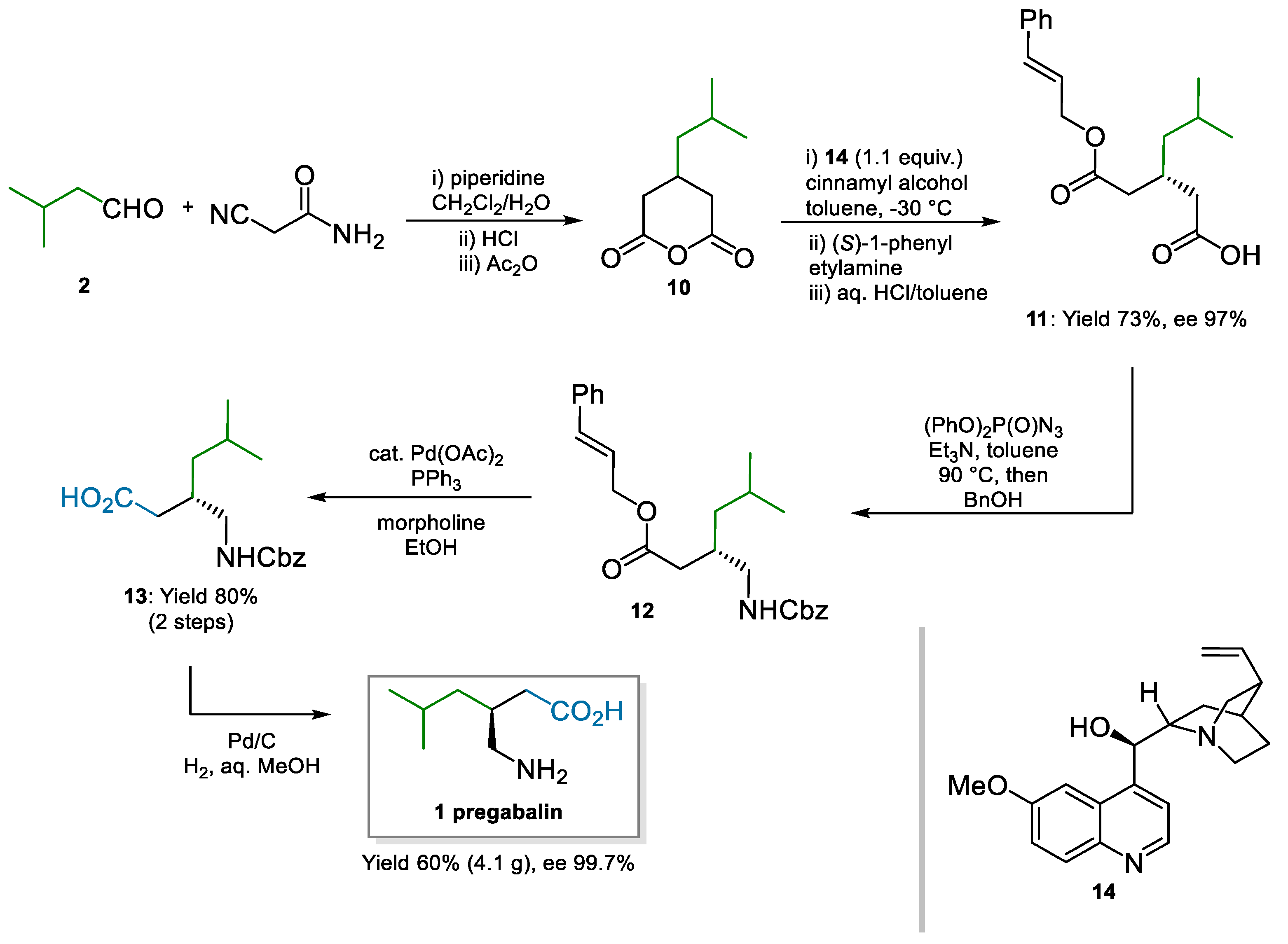
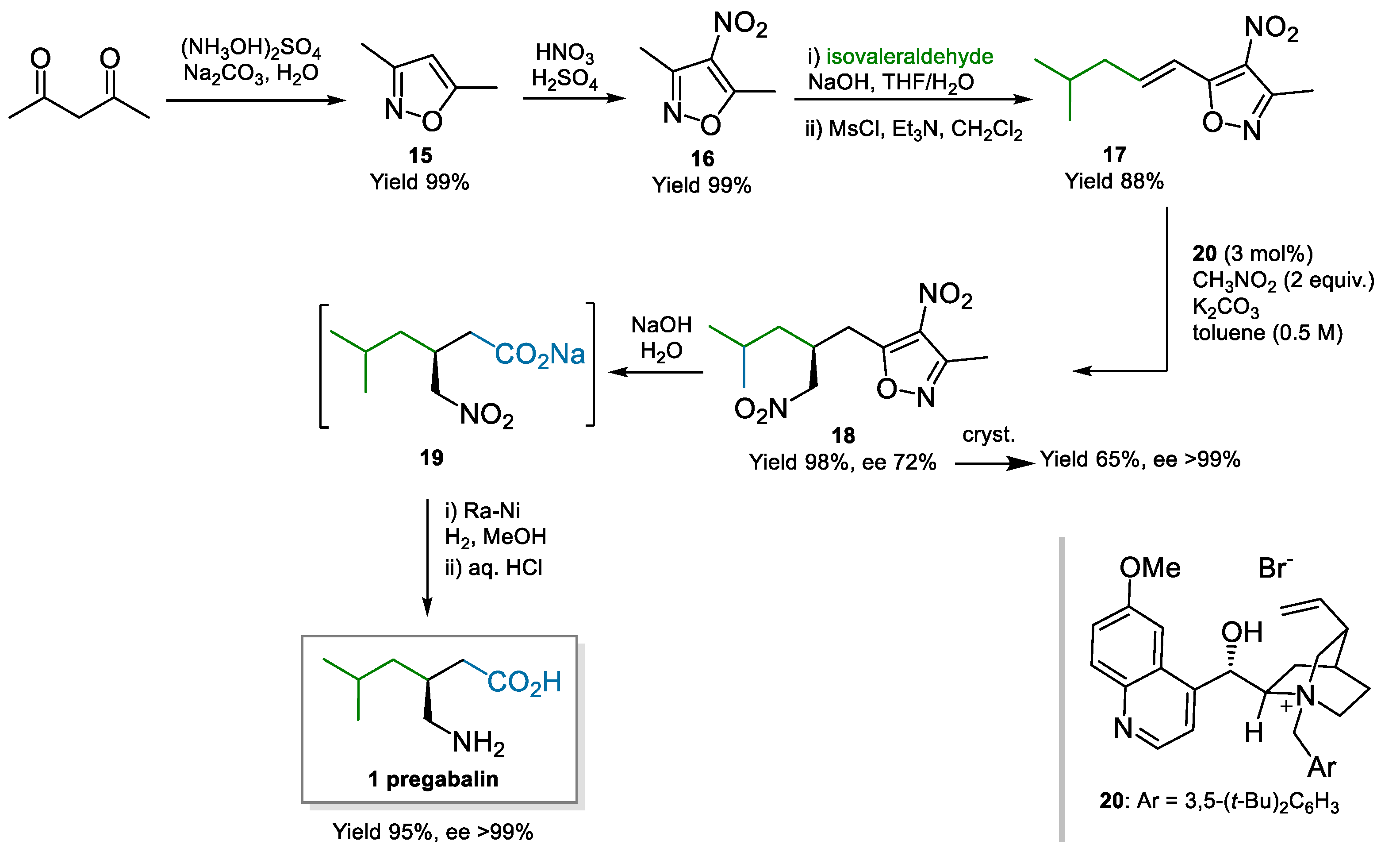

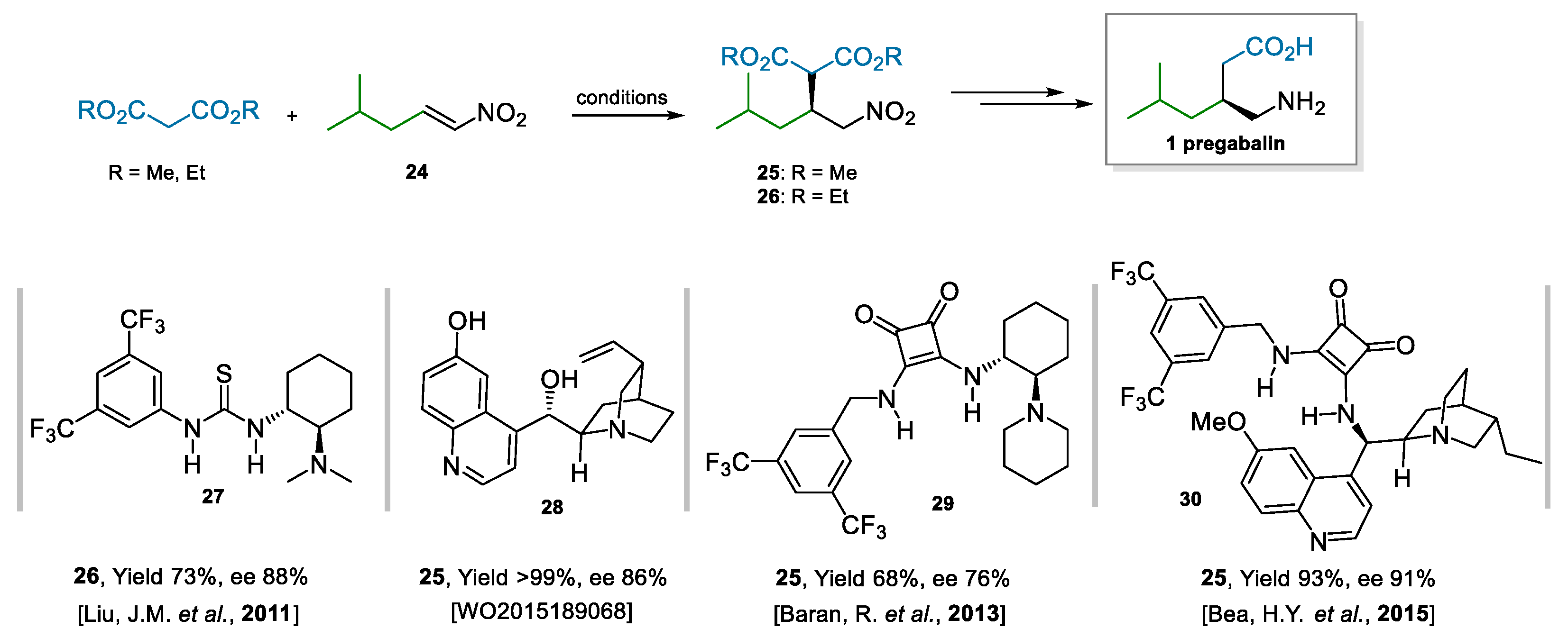
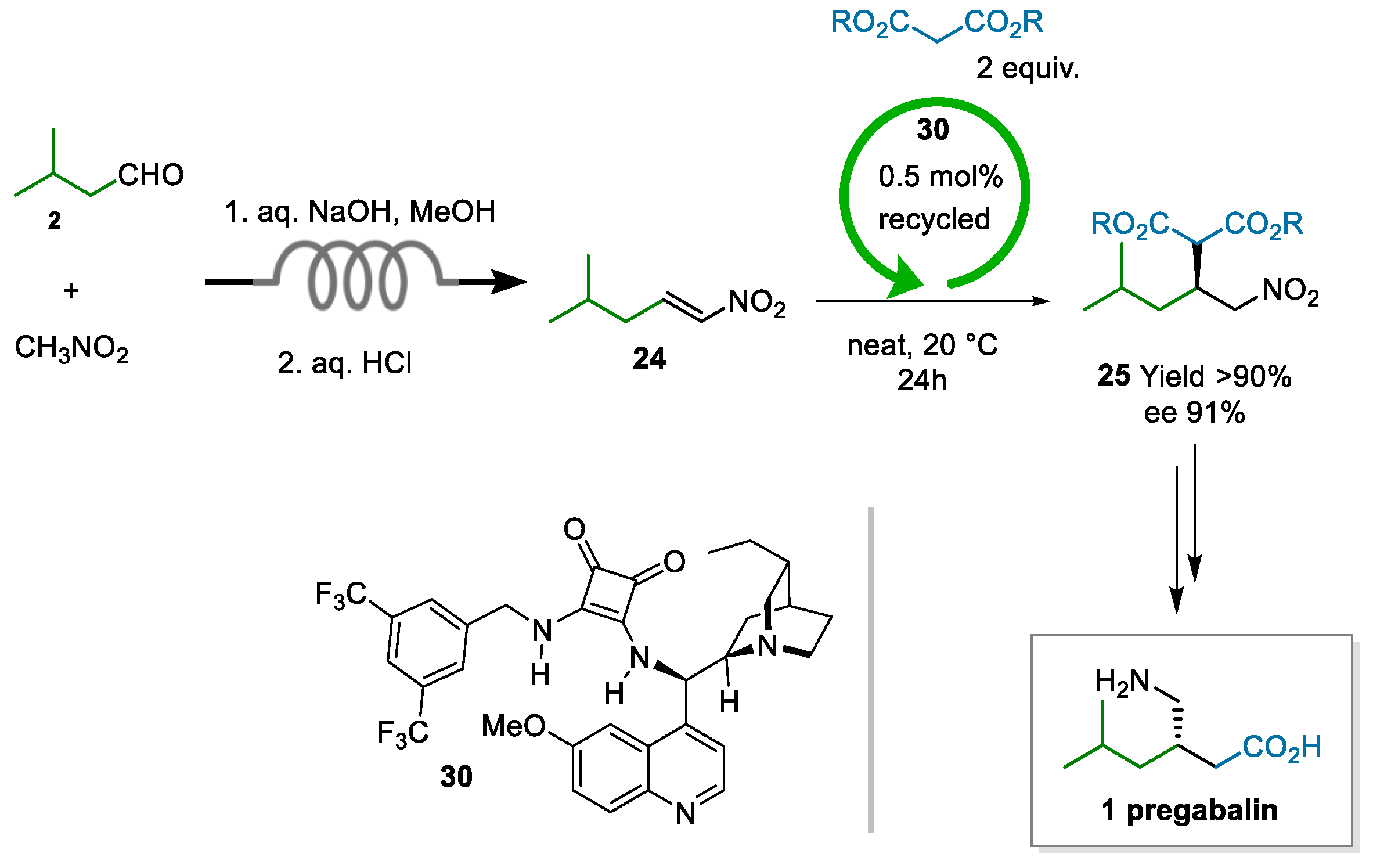
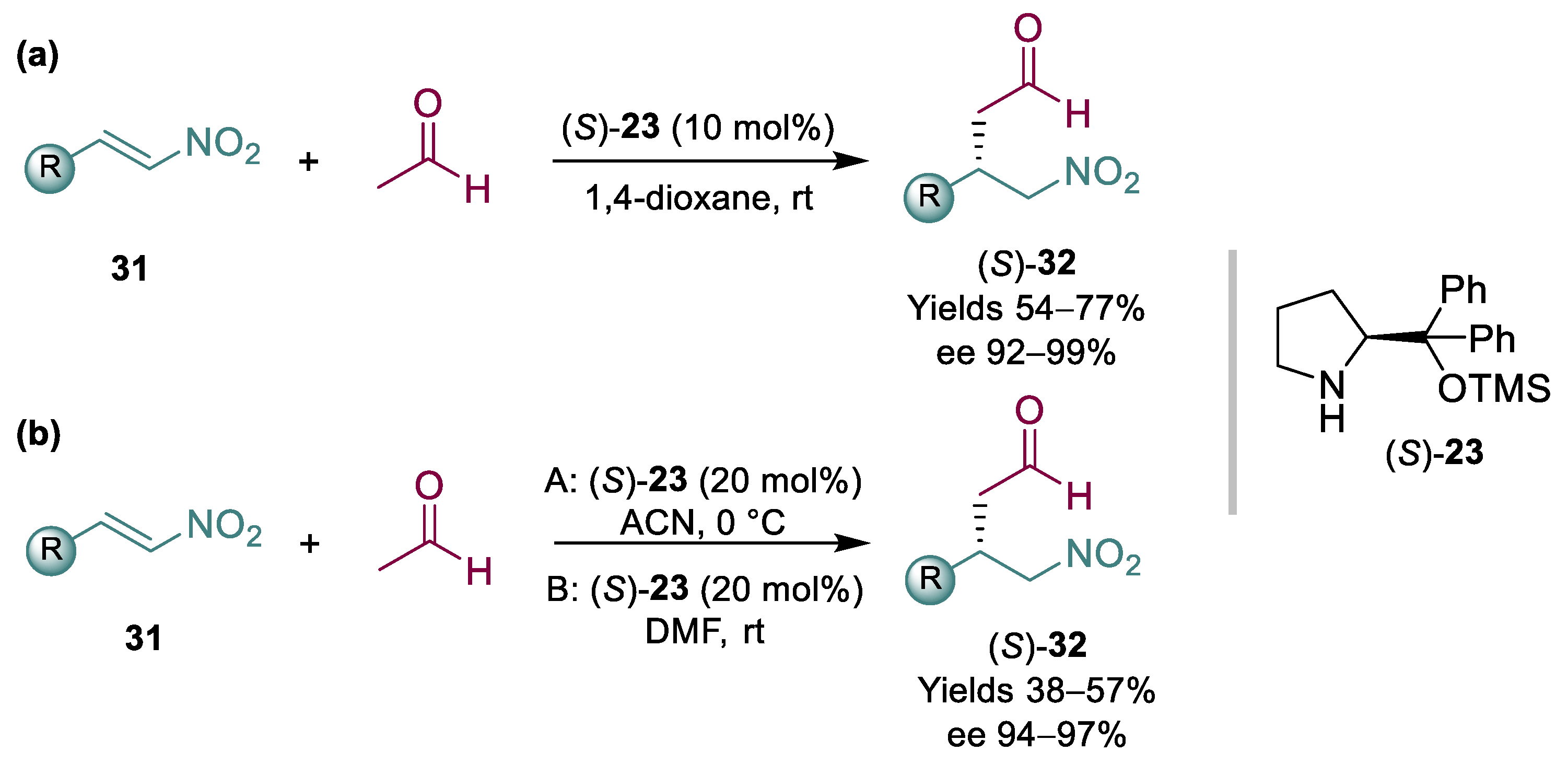
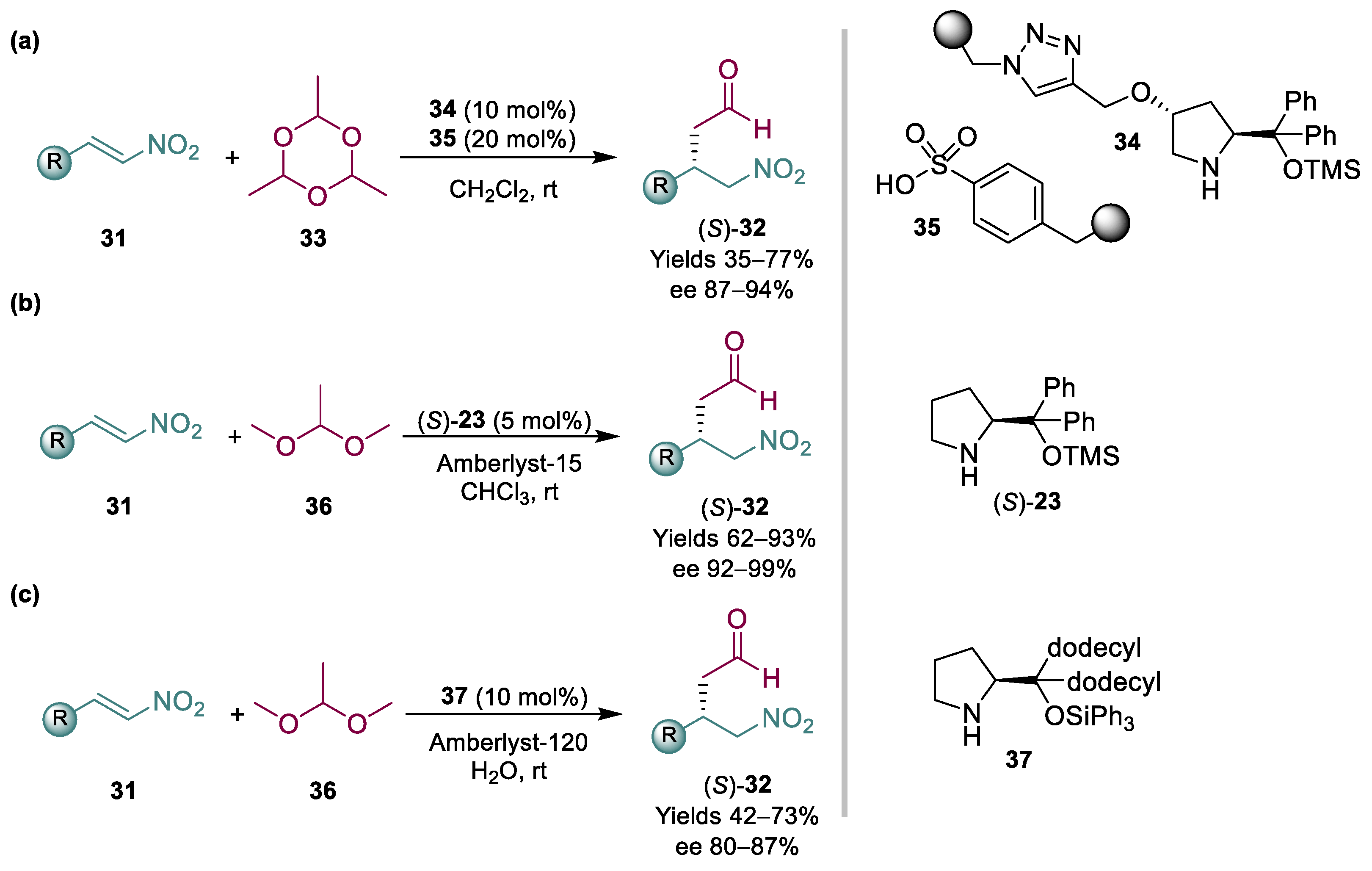
Publisher’s Note: MDPI stays neutral with regard to jurisdictional claims in published maps and institutional affiliations. |
© 2022 by the authors. Licensee MDPI, Basel, Switzerland. This article is an open access article distributed under the terms and conditions of the Creative Commons Attribution (CC BY) license (https://creativecommons.org/licenses/by/4.0/).
Share and Cite
Giorgianni, G.; Bernardi, L.; Fini, F.; Pesciaioli, F.; Secci, F.; Carlone, A. Asymmetric Organocatalysis—A Powerful Technology Platform for Academia and Industry: Pregabalin as a Case Study. Catalysts 2022, 12, 912. https://doi.org/10.3390/catal12080912
Giorgianni G, Bernardi L, Fini F, Pesciaioli F, Secci F, Carlone A. Asymmetric Organocatalysis—A Powerful Technology Platform for Academia and Industry: Pregabalin as a Case Study. Catalysts. 2022; 12(8):912. https://doi.org/10.3390/catal12080912
Chicago/Turabian StyleGiorgianni, Giuliana, Luca Bernardi, Francesco Fini, Fabio Pesciaioli, Francesco Secci, and Armando Carlone. 2022. "Asymmetric Organocatalysis—A Powerful Technology Platform for Academia and Industry: Pregabalin as a Case Study" Catalysts 12, no. 8: 912. https://doi.org/10.3390/catal12080912
APA StyleGiorgianni, G., Bernardi, L., Fini, F., Pesciaioli, F., Secci, F., & Carlone, A. (2022). Asymmetric Organocatalysis—A Powerful Technology Platform for Academia and Industry: Pregabalin as a Case Study. Catalysts, 12(8), 912. https://doi.org/10.3390/catal12080912







